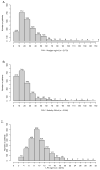Comparison of plasminogen activator inhibitor-1, tissue type plasminogen activator antigen, fibrinogen, and D-dimer levels in various age decades in patients with type 2 diabetes mellitus and stable coronary artery disease (from the BARI 2D trial)
- PMID: 20102884
- PMCID: PMC2814593
- DOI: 10.1016/j.amjcard.2009.08.643
Comparison of plasminogen activator inhibitor-1, tissue type plasminogen activator antigen, fibrinogen, and D-dimer levels in various age decades in patients with type 2 diabetes mellitus and stable coronary artery disease (from the BARI 2D trial)
Abstract
Advancing age is associated with downregulation of fibrinolysis in normal subjects. This is reflected by high concentrations of plasminogen activator inhibitor-1 (PAI-1) in the blood, which has been implicated in the increasing cardiovascular morbidity and mortality with age. We sought to delineate the relation of PAI-1 to several factors, including age, gender, and ethnicity in patients with type 2 diabetes mellitus (DM) and stable coronary artery disease enrolled in the Bypass Angioplasty Revascularization Investigation 2 Diabetes (BARI 2D) trial. A total of 2,321 patients with DM and stable coronary artery disease in the BARI 2D trial were grouped by age (<50, 50 to 59, 60 to 69, and > or =70 years). Tissue-type plasminogen activator antigen, PAI-1 antigen and activity, fibrinogen, and D-dimer were quantified at baseline. The PAI-1 antigen (p <0.001) and its activity (p <0.001) and their ratios to tissue-type plasminogen activator (p <0.001) were all paradoxically lower with advancing age. In contrast, D-dimer (p <0.0001) was elevated. The fibrinogen level was greatest in the oldest age group (p = 0.01). The level of tissue-type plasminogen activator antigen did not vary with age. These age-related differences were observed primarily in men and non-Hispanic white and Asian/other participants. In conclusion, PAI-1 is inversely related to age in patients with DM and stable coronary artery disease and is associated with elevation of D-dimer, reflecting augmented fibrinolysis. The unexpected profibrinolytic state seen with advancing age and DM might reflect a protective phenomenon resulting from enhanced survival of some older patients with DM that endowed the older patients with longevity sufficient to enable them to participate in the BARI 2D trial. Targeting the factors that led to the downregulation of PAI-1 in older patients with type 2 DM might offer an attractive strategy for reducing cardiovascular risk.
Figures



Similar articles
-
Thrombotic/Thrombolytic Balance as a Cardiac Treatment Determinant in Patients With Diabetes Mellitus and Coronary Artery Disease.J Am Heart Assoc. 2019 Jan 22;8(2):e011207. doi: 10.1161/JAHA.118.011207. J Am Heart Assoc. 2019. PMID: 30646801 Free PMC article. Clinical Trial.
-
Profibrinolytic, antithrombotic, and antiinflammatory effects of an insulin-sensitizing strategy in patients in the Bypass Angioplasty Revascularization Investigation 2 Diabetes (BARI 2D) trial.Circulation. 2011 Aug 9;124(6):695-703. doi: 10.1161/CIRCULATIONAHA.110.014860. Epub 2011 Jul 18. Circulation. 2011. PMID: 21768545 Free PMC article. Clinical Trial.
-
Type 2 Diabetes and Cardiovascular Factors Contrasted with Fibrinolysis Disorders in the Blood of Patients with Peripheral Arterial Disease.Medicina (Kaunas). 2019 Jul 22;55(7):395. doi: 10.3390/medicina55070395. Medicina (Kaunas). 2019. PMID: 31336615 Free PMC article.
-
Impaired fibrinolytic compensation for hypercoagulability in obese patients with type 2 diabetes: association with increased plasminogen activator inhibitor-1.Metabolism. 2002 Apr;51(4):471-6. doi: 10.1053/meta.2002.31334. Metabolism. 2002. PMID: 11912556
-
D-Dimer as Biomarker for Prognosis of Coronary Artery Disease and Heart Failure: Reappraisal of Its Central Role.Cardiology. 2025 May 8:1-11. doi: 10.1159/000546154. Online ahead of print. Cardiology. 2025. PMID: 40340891 Review.
Cited by
-
Prognostic Value of Age-Adjusted D-Dimer Cutoff Thresholds in Patients with Acute Coronary Syndrome Treated by Percutaneous Coronary Intervention.Clin Interv Aging. 2022 Feb 9;17:117-128. doi: 10.2147/CIA.S347168. eCollection 2022. Clin Interv Aging. 2022. PMID: 35173426 Free PMC article.
-
Thrombotic/Thrombolytic Balance as a Cardiac Treatment Determinant in Patients With Diabetes Mellitus and Coronary Artery Disease.J Am Heart Assoc. 2019 Jan 22;8(2):e011207. doi: 10.1161/JAHA.118.011207. J Am Heart Assoc. 2019. PMID: 30646801 Free PMC article. Clinical Trial.
-
Effects of candesartan in hypertensive patients with type 2 diabetes mellitus on inflammatory parameters and their relationship to pulse pressure.Cardiovasc Diabetol. 2012 Oct 3;11:118. doi: 10.1186/1475-2840-11-118. Cardiovasc Diabetol. 2012. PMID: 23034088 Free PMC article. Clinical Trial.
-
Relationship between fibrinogen levels and cardiovascular events in patients receiving percutaneous coronary intervention: a large single-center study.Chin Med J (Engl). 2019 Apr 20;132(8):914-921. doi: 10.1097/CM9.0000000000000181. Chin Med J (Engl). 2019. PMID: 30958432 Free PMC article.
-
Glycosylated hemoglobin A1c as a marker predicting the severity of coronary artery disease and early outcome in patients with stable angina.Lipids Health Dis. 2014 May 29;13:89. doi: 10.1186/1476-511X-13-89. Lipids Health Dis. 2014. PMID: 24884794 Free PMC article.
References
-
- Sobel BE, Frye R, Detre KM. Bypass Angioplasty Revascularization Investigation 2 Diabetes Trial. Burgeoning dilemmas in the management of diabetes and cardiovascular disease: rationale for the Bypass Angioplasty Revascularization Investigation 2 Diabetes (BARI 2D) Trial. Circulation. 2003;107:636–642. - PubMed
-
- Brooks MM, Frye RL, Genuth S, Detre KM, Nesto R, Sobel BE, Kelsey SF, Orchard TJ Bypass Angioplasty Revascularization Investigation 2 Diabetes (BARI 2D) Trial Investigators. Hypotheses, design, and methods for the Bypass Angioplasty Revascularization Investigation 2 Diabetes (BARI 2D) Trial. Am J Cardiol. 2006;97:9G–19G. - PubMed
-
- Sobel BE. BARI 2D Trial Investigators. Ancillary studies in the Bypass Angioplasty Revascularization Investigation 2 Diabetes (BARI 2D) Trial: Synergies and opportunities. Am J Cardiol. 2006;97:53G–58G. - PubMed
-
- Kruszynska Y, Yu JG, Sobel BE, Olefsky JM. Effects of troglitazone on blood concentrations of plasminogen activator inhibitor 1 in patients with type 2 diabetes mellitus and in lean and obese normal subjects. Diabetes. 2000;49:633–639. - PubMed
-
- Yamamoto K, Takeshita K, Kojima T, Takamatsu J, Saito H. Aging and plasmiongen activator inhibitor-1 (PAI-1) regulation: Implication in the pathogenesis of thrombotic disorders in the elderly. Cardiovasc Res. 2005;66:276–285. - PubMed
Publication types
MeSH terms
Substances
Grants and funding
LinkOut - more resources
Full Text Sources
Medical
Miscellaneous

